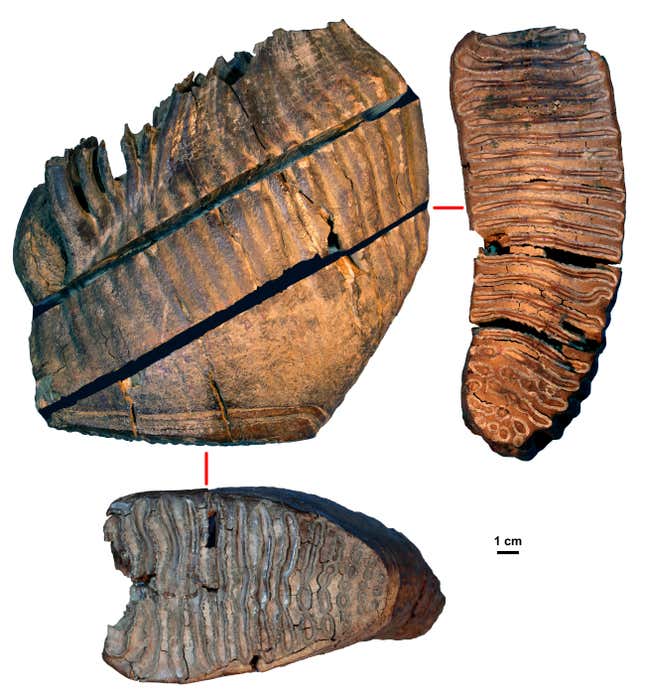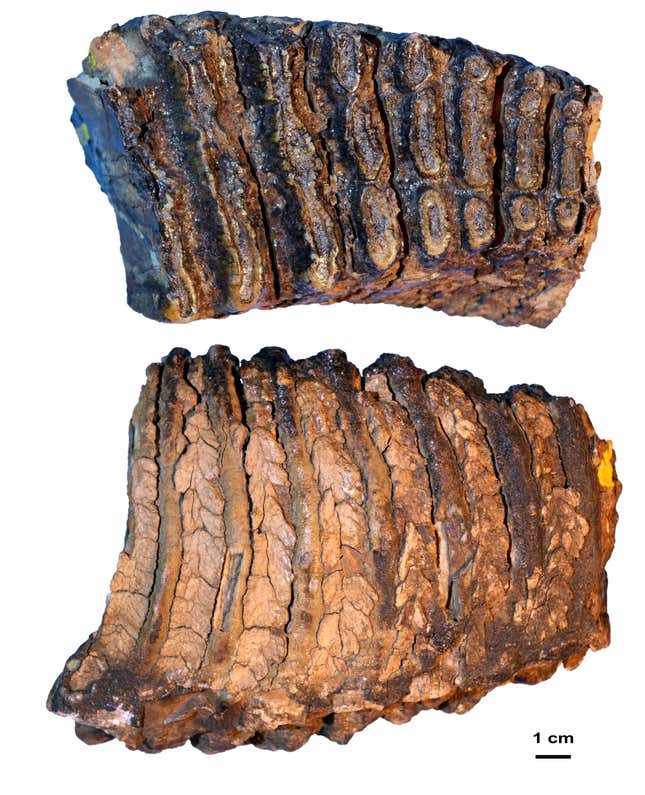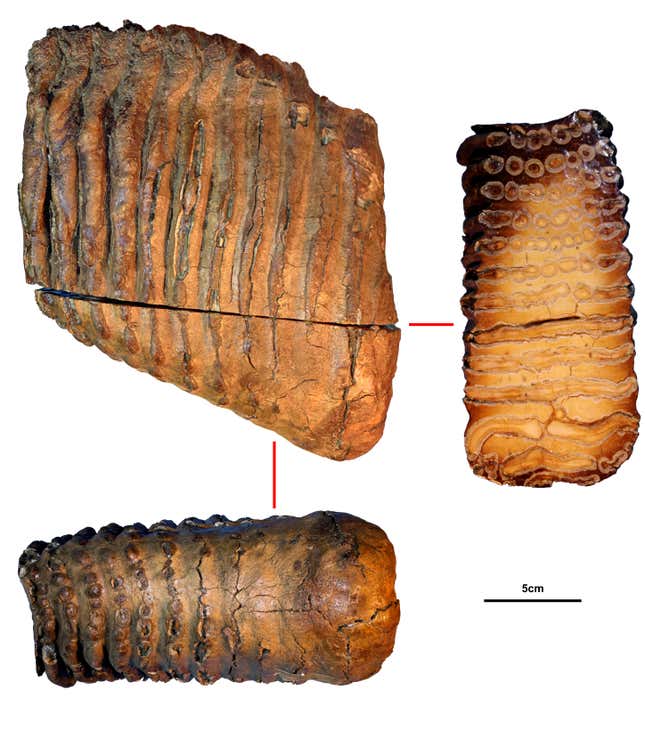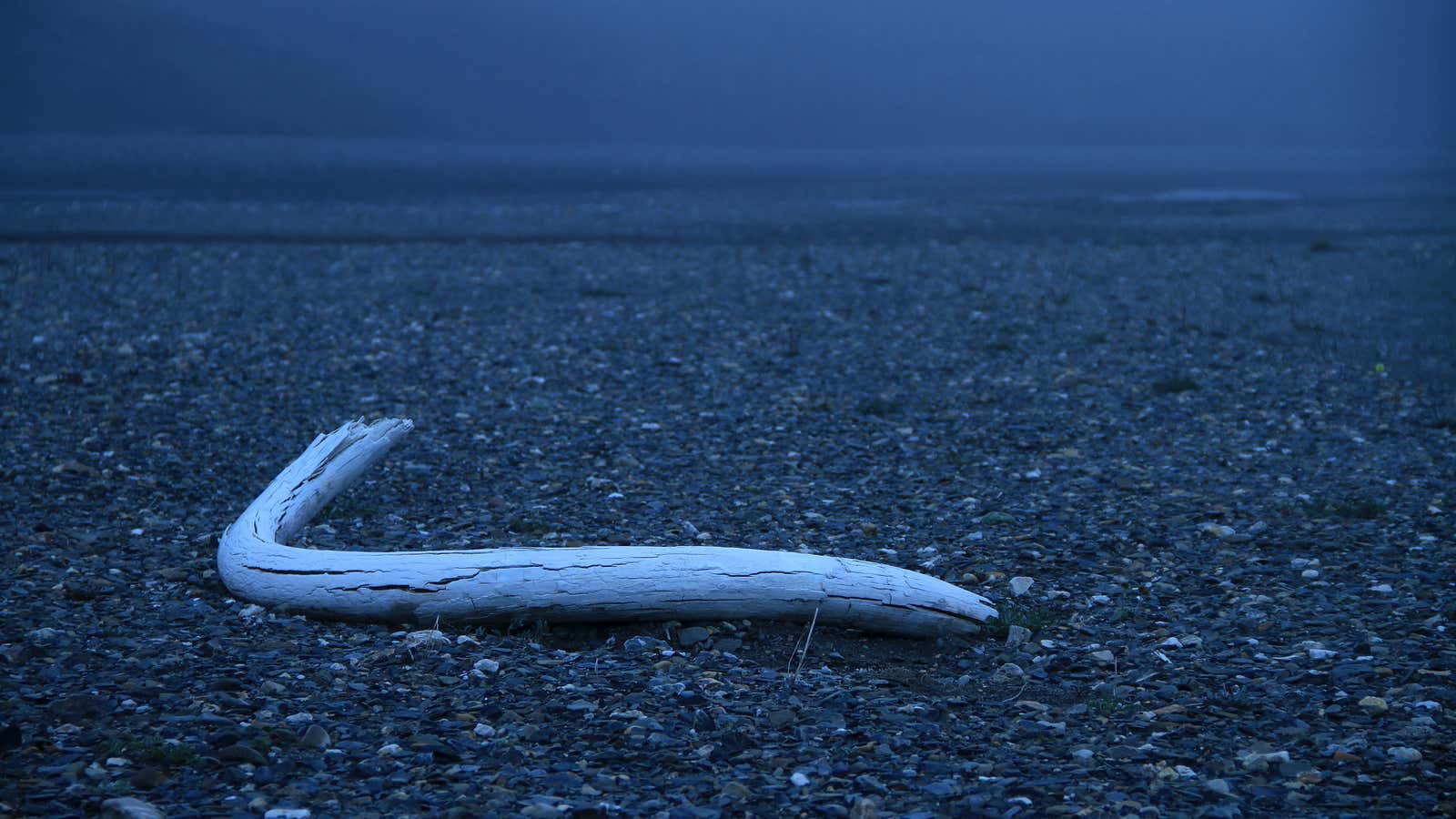An international team of scientists has sequenced DNA from mammoth teeth that is at least a million years old, if not older. This research, published today in Nature, not only provides exciting new insight into mammoth evolutionary history, it reveals an entirely unknown lineage of ancient mammoth.
The woolly mammoth (Mammuthus primigenius) may rival T. rex in popular imagination, but it is, in fact, one of the last mammoth species to have evolved, and it’s only one of various, sometimes odd-looking species of large, tusked animals belonging to the order Proboscidea. Mammoths are believed to have originated in Africa approximately 5 million years ago, with populations traveling north into what is now Eurasia and eventually moving into North America. We still have much to learn about these ancient proboscidean predecessors, which is why this new research is remarkably important. We know, for example, that woolly mammoths were adapted for life in the high Arctic: They could withstand the cold, they could survive on the available vegetation, and they grew thick, tangled hair that gave rise to their name. But when did these adaptations appear? And what about the mammoth species that lived before their woolly counterparts?

A million years is an extraordinary amount of time—too long for genetic material to survive, or so some scientists once thought. The newly discovered DNA, pulled from three mammoth teeth discovered in Siberia in the 1970s, is now offering an unprecedented window into another time on Earth. The three mammoth molars are nicknamed Krestovka, Adycha, and Chukochya after the rivers and locations near where they were excavated. The team estimated the age of these fossils using several lines of evidence: the geologic dating of the sediment layer in which they were found, the morphological—or the structural—attributes of the teeth, and genetic dating.
Chukochya belonged to the most recent mammoth in this sample, a creature that lived 500,000 to 800,000 years ago. At this age, Chukochya is an early form of the woolly mammoth species.
Adycha belonged to a mammoth who lived about 1 million to 1.2 million years ago. Considerably older than Chukochya, this mammoth is similar to the steppe mammoth (Mammuthus trogontherii), a species known throughout Eurasia until its extinction around 200,000 years ago. Late in its existence, the steppe mammoth co-existed with woolly mammoths, but prior to this research, it was believed to live in warmer climates and have considerably less hair than the woolly—something that now seems not to be the case.
Krestovka, the most ancient molar of the three, is approximately 1.1 million to 1.2 million years old. And what the team discovered about its particular evolutionary lineage provided perhaps the most exciting discovery of all.

Because the fossils sampled for this research are older than the previous oldest DNA on record—from a 560,000- to 780,000-year-old horse—obtaining any DNA at all was a surprise, according to study co-author Beth Shapiro, a professor at UC Santa Cruz and investigator at the Howard Hughes Medical Institute. She and her co-authors attribute their success to the fossils’ preservation in permafrost.
“If the dirt (and bones) thaw, this is bad for the DNA, which will break down as water expands and contracts,” Shapiro explained in an email to Gizmodo. “This is why most very old bones have no recoverable DNA—it is simply too degraded.”
The team, working with only fragments of the larger genetic picture, found that many of the cold adaptations actually evolved in mammoths prior to the emergence of the woolly mammoth as a distinct species. Unlike previously believed, woolly mammoths didn’t evolve these adaptations over time; they already had them. Those adaptations appear to have evolved in one of its mammoth predecessors, a species that lived throughout Eurasia: the steppe mammoth (Mammuthus trogontherrii).

“What we show now is that the Adycha mammoth seems to have had nearly all of the Arctic adaptations that the woolly mammoths had. It had genes related to fat deposits, thermoregulation, thermal sensation, and circadian rhythms,” Love Dalén, professor of evolutionary genetics at the Swedish Museum of Natural History, research leader at the Centre for Palaeogenetics, and study co-author, said in a video call with Gizmodo. “So that means two things: First, we have to rethink what the steppe mammoths looked like. They probably were much more cold-adapted and woolly. But it also means that the origin of the woolly mammoth is not associated with this rapid burst of evolution. Instead, for all we can see, the thing that changes is the teeth!”
Teeth in proboscideans such as mammoths are the most reliable skeletal identifiers and often the only remnants that survive fossilization. It is because of this that Adrian Lister, a paleobiologist at London’s Natural History Museum and study co-author, insisted that the team use these three molars.
The teeth were initially discovered in the 1970s by the late Russian scientist Andrei Sher. Over the course of their long friendship and scientific partnership, Sher and Lister studied these molars, along with the innumerable others Sher had collected in Russia and those in collections throughout Europe and North America. The technology to potentially study the DNA of such specimens, however, did not become available until the last decade. It wasn’t until work commenced for this recent study that scientists actually drilled into the molars, extracted DNA, converted the DNA into “libraries,” and then sequenced them for analysis.
“If we go back 20 years in time, scientists were able to sequence thousands or tens of thousands of reads,” said bioinformaticist and one of the three lead authors on this paper, Tom van der Valk, in a video interview. “Ten years ago, this increased to a few million reads. In this project, we literally generated billions of billions of reads to extract as much DNA information as we could possibly get.”
A “read,” explained Shapiro, is a “30-60 base-pair fragment of DNA isolated from the bone.” Or, if we were to compare one DNA fragment to a book, each read would be the equivalent of a word in that book.
The rapid pace at which genetic technology has advanced means that Dalén, who began his career in genetics less than 20 years ago, had a profoundly different experience with DNA sequencing than the younger generation now working in his lab.

“When we started working on mammoths 15 years ago, we were sequencing a couple of hundred base pairs of mitochondrial DNA, and we were super proud about that,” Dalén said. “Now we’re sequencing whole genomes. It’s a big difference.”
Dalén was part of the team that sequenced the entire woolly mammoth genome in 2015, and, in the beginning, he could actually look at the smaller mitochondrial sequences and recognize which ones belonged to mammoths. At that time, he said, the sequences “were only a few hundred base pairs long. They almost became like your friends; you recognized them. Now, it’s impossible. The genome is well over 3 billion base pairs long!”
David Díez-del-Molino, evolutionary biologist and another lead author, tried to explain what he and other scientists work with when DNA is sequenced into computers. Though we might immediately conjure up the cute animation in the film Jurassic Park, the reality is that the data, with the billions of letters that make up the genome, is almost impossible to fully fathom. (For those wondering if this research brings us closer to reviving dinosaurs, or even mammoths: It does not.)
As van der Valk described, “When we got back the data, I could take a small part of the data, open it on my screen and see the DNA code. But there is no human on Earth that can literally read what it says there.”
“The data generation and the DNA technologies have been evolving so rapidly that now it’s at a point where the computers are the limitation,” van der Valk said. “Our data storage and our computational speeds are more limiting in a way than the data generation.”
Van der Valk and Díez-del-Molino worked on the data analysis, but first it had to be sequenced and its relation to the mammoth genome mapped. This work was done by Patrícia Pečnerová, evolutionary biologist and another lead author. But even this work is hard for anyone outside of the field to fully grasp. Remember, what they recovered were not complete DNA strands; they were fragmentary.

Pečnerová offered the image of one-square-meter jigsaw puzzle. That puzzle, composed of 1,000 pieces, would be considerably easier to piece together than a puzzle of 10,000 smaller pieces. “Especially,” she said, “if you imagine the cover on the box is not a mammoth but an elephant, because we are using elephant reference genomes.” Imagine, too, that pieces of the puzzle can easily fit in several places.
Confirming that the DNA they had was indeed authentic and then making sense of these genetic fragments was a gradual process. It took teams of people from nine countries using a variety of methods to gather and fully understand what the data was saying, particularly the puzzling data surrounding Krestovka and its relation to the North American Columbian mammoth (Mammuthus columbi). It finally clicked late one night when van der Valk and Dalén were in front of a white board. Dalén recalls exclaiming, “It’s a hybrid! Bloody hell, it’s a hybrid!”
So that’s why there was so much confusion surrounding Krestovka. They were looking at a completely unknown lineage of mammoth, which coexisted with woolly mammoths during the middle Pleistocene in Siberia. To date, we have no other fossils that offer more details of this type of mammoth. Moreover, the lineage represented by Krestovka appears to have bred with woolly mammoths, leading to the emergence of the Columbian mammoth. In other words, they found the ancestor to an eventual mammoth hybrid that moved out of Siberia and into North America, becoming what we know as the enormous Columbian mammoth. This, according to Lister, is a significant discovery. Scientists are only beginning to understand hybridization in mammals.
Mirte Bosse, researcher of conservation genomics at Wageningen University who was not involved in this study, said in an email, “I think this finding tells an important story by demonstrating that interbreeding between genetically highly distinct lineages is not as uncommon as previously thought, and is not only happening in recent times because of climatic shifts, but is a phenomenon that also happened much longer ago, at times without direct human impact.”
For Dick Mol, a researcher with the Natural History Museum Rotterdam who was not part of this team but has spent half a century studying mammoths, this research is “a milestone.” He said the history of mammoths “appears to be more complicated than initially assumed.”
Lister, who has spent almost his entire career studying mammoths, is enthusiastic about the DNA work. He and Sher spent decades manually measuring and observing mammoth teeth from Russia, other parts of Europe, and North America before Sher’s death in 2008. Evolutionary changes can be seen, even if broadly, within the morphology of mammoth teeth.
“To me, this is the most interesting thing,” Lister said of genetic research, “because we can start to find out more about the animal as a living creature. As paleontologists—I hate saying the word ‘never’ in science, but I will say it—we could NEVER have known that from the bones. That kind of thing is wonderful.”
Miet Germonpré, paleontologist at the Royal Belgian Institute of Natural Sciences who was not involved in the new research, expressed amazement that the team was able to uncover DNA that old. “This is thanks to the cold climate that was more or less continuously present in the Far North of Siberia,” she wrote in an email. “This means that the DNA in remains of other species from that time range in this region could be studied in the future as well, leading to good results.”
Indeed, the team hopes their success will encourage other scientists to start searching for equally ancient DNA in other fossils.
“I think there’s so much we don’t know about this time period around a million years ago,” Dalén said. “Not only for mammoths—I think the whole evolution of mammals at that time is probably very incomplete, because it’s based on paleontology alone. I’m pretty sure that when we start looking at other species, which of course we will do, that we’re going to find similar kinds of surprises.”
Shapiro agrees. “The past, by its very nature, is different from the present, and so is ripe for discovery,” she said. “As technology improves such that we can access evolutionary information—DNA or proteins or other preserved biomolecules—from older or more poorly preserved fossils, we will learn more about how species, populations, and ecosystems evolved. And I have no doubt that we will continue to be surprised by what we discover.” The question posed by Pečnerová is: “How far can we go?”
Jeanne Timmons (@mostlymammoths) is a freelance writer based in New Hampshire who blogs about paleontology and archaeology at mostlymammoths.wordpress.com.
